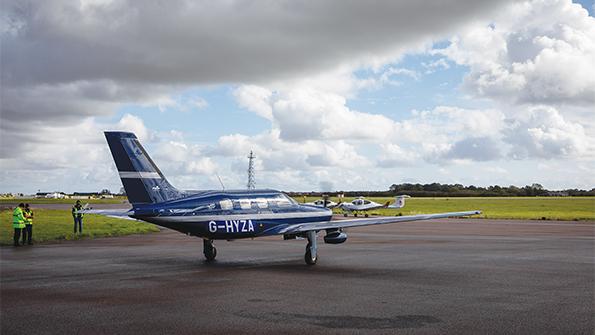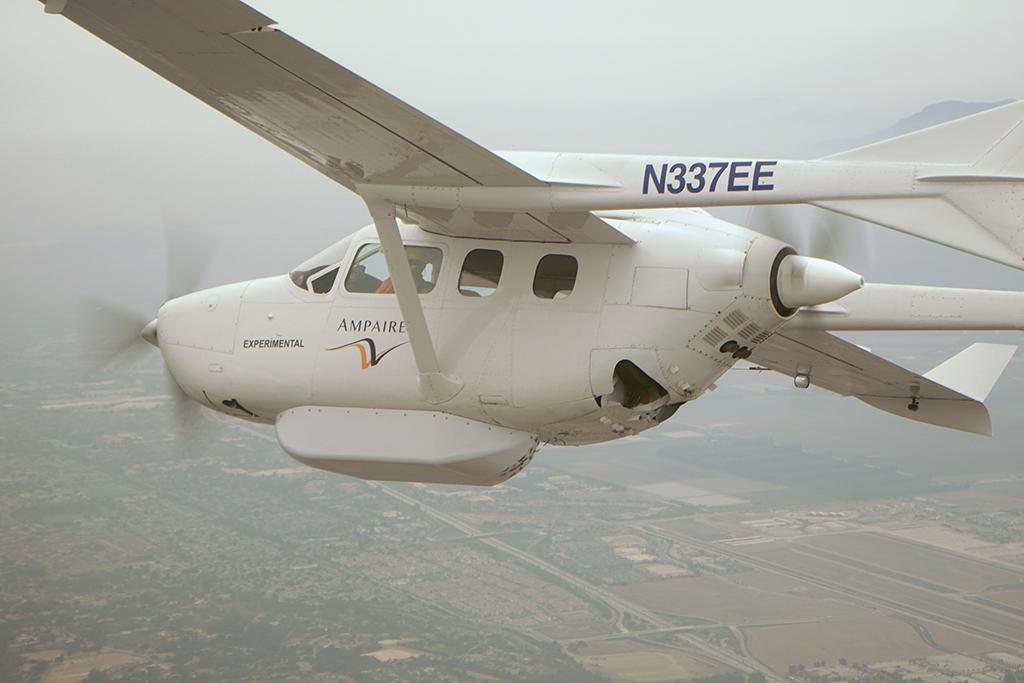Sustainability Report: Hybrid-Electric Regional Aircraft Tests Ramp Up

The UK has become a focus for efforts to revitalize short-haul regional air transport by tapping into the cost and emissions reductions promised by electrified aircraft propulsion.
Flight tests of a hybrid-electric testbed have been conducted on regional routes in Scotland and England to showcase the potential benefits of using electric motors in combination with combustion engines. And zero-emission hydrogen-electric propulsion is being developed under multiple UK government-supported projects.
The UK is not alone in believing there is pent-up demand for the short-haul, point-to-point flying that birthed the regional airlines. In the US, proponents point to the loss of service suffered by smaller communities as regional aircraft have grown into bigger hub feeders. In Europe, they point to the inequality in connectivity between cities with high-speed rail links and those without.

All agree that the demand, if it is there, can only be unlocked by the development of aircraft that dramatically reduce the cost, and climate impact, of flying. And just as advances in propulsion have always led to new generations of aircraft, the powertrain developers are taking the lead.
Electric EEL trials
The August trials in Orkney, Scotland, and southwest England involved the Electric EEL, a Cessna 337 Skymaster converted to hybrid-electric propulsion by US startup Ampaire. The aircraft’s forward piston engine has been replaced with an electric motor, which operates in parallel with the aft piston engine. The battery pack powering the motor is housed in a fairing under the fuselage.
The aircraft made several flights from Kirkwall Airport on Orkney island to Wick John O’Groats Airport about 40 miles away on the Scottish mainland, using about 30% less fuel than an unmodified Skymaster, Ampaire says. Later in August, the testbed was relocated to Exeter Airport in Devon to conduct test flights to Cornwall Airport Newquay some 85 miles away.
The Exeter flights were conducted under the 2ZERO project supported by the government under its £300 million ($415 million) Future Flight Challenge. Under Phase 2 of 2ZERO, now being proposed for the final two years of the challenge, the Ampaire-led team plans to retrofit a hybrid-electric powertrain into a 19-seat de Havilland Canada Twin Otter for UK flight demonstrations. Scottish island-hopping airline Loganair is part of the 2ZERO project.
Ampaire sees hybrid-electric powertrains as a bridge to zero-emission all-electric propulsion in that they offer significant energy savings but do not require charging infrastructure to be installed at every airport served as the aircraft can recharge themselves.
“In most of these regions, it’s challenging to get the right type of power or enough power to charge the planes initially,” Ampaire CEO Kevin Noertker said. “If we required it all to be charged, with charging stations on the ground, then few airports would be able to receive these planes in the near term.”
Noting Toyota’s Prius hybrid automobile is still in production after 25 years despite the availability of all-electric cars, the US startup believes hybrid-electric aircraft will have a long service life as aviation transitions to lower-carbon alternatives.
Surf Air Mobility, which is to acquire Ampaire, in July agreed to purchase up to 150 Cessna Caravans from Textron Aviation for conversion to hybrid-electric propulsion. The company plans to use the nine-passenger aircraft to build an electric regional network in the US, and also intends to sell the electrified Caravans to other operators.
Hydrogen fuel cells
How long any hybrid-to-electric bridge period might last is yet to be seen because another technology is making a play for leadership in decarbonizing short-haul aviation. And that technology uses hydrogen in fuel cells to generate electricity to power motors with no emissions except heat and water vapor.
Here again, the UK has become an early focus of activity, with the government providing funding to support development of hydrogen-electric propulsion for regional aircraft. Efforts include the HyFlyer II project, under which US/UK startup ZeroAvia is developing a fuel-cell powertrain for retrofit to 19-passenger aircraft. A modified Dornier 228 is planned to fly in the UK this year and ZeroAvia is aiming for commercial availability in 2024.
The propulsion system for nine-seat single- and 19-seat twin-turboprops uses gaseous hydrogen in pressurized tanks and provides a 500-mile range. ZeroAvia is also developing a more powerful fuel-cell system for 50-seat-plus regional aircraft. This will use cryogenic liquid hydrogen and offer greater range. Commercial availability is planned for 2026.
Another UK-backed effort, Project Fresson led by Cranfield Aerospace Solutions, began with the intent to retrofit the island-hopping Britten-Norman Islander with hybrid-electric propulsion but has switched to hydrogen fuel cells. A prototype is planned to fly in late 2022. Loganair, which operates nine-passenger Islanders in Orkney, is supporting the project.
The willingness of short-haul operators such as Loganair and Surf Air to be early adopters of electrified propulsion could prove crucial. Cape Air, the largest commuter airline in the US, is already working with startup Eviation as it develops the nine-passenger all-electric Alice. First flight is expected this year.
Cape Air is renewing its fleet, replacing aging Cessna 402s with 11-passenger Tecnam P2012 Travellers. The Traveller has twin piston engines, but the airline is eyeing the nine-seat all-electric P-Volt version now under development by Tecnam and Rolls-Royce, founder and CEO Dan Wolf says.
There would still be room in Cape Air’s fleet for the Alice. “There’s still a use for the Eviation airplane because it’s faster and might conceivably have a different use than the Tecnam airplane,” Wolf said. “We’re committed over the next five to 10 years to going electric, but I think we’ll do it in phases.”
But from hybrid to hydrogen, the current interest in electrified regional aviation is predicated on the promised cost savings. The cost of producing green hydrogen using renewable electricity must come down as projected and the cost of electricity must not increase significantly if this is to work.
Manufacturers are projecting operating cost reductions of up to 80% with electrification, but that is based on assumptions about the cost of electricity.
“If we are looking at a 15 cents per kilowatt-hour basis, it looks really good. It doesn’t work if you are talking about 75 cents a kilowatt-hour,” Wolf noted.
The cost of electricity to aviation will not be what the consumer pays. “The cost of electricity into the airplane is going to have to cover the cost of the infrastructure. A lot of airport revenue comes from fuel sales, so we have to assume airports are going to look at some kind of flow change,” Wolf said.
These are the types of questions manufacturers and airports are looking to answer with trials such as those conducted by Ampaire in Scotland and England. With more demonstrations planned over the next two years, the UK plans to play a key role in helping answer those questions.


